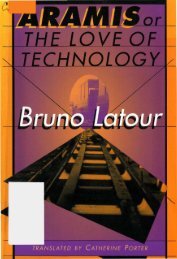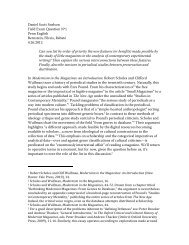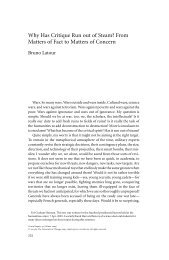The Exploit: A Theory of Networks - asounder
The Exploit: A Theory of Networks - asounder
The Exploit: A Theory of Networks - asounder
You also want an ePaper? Increase the reach of your titles
YUMPU automatically turns print PDFs into web optimized ePapers that Google loves.
52 Nodes<br />
search field that gets exponentially larger as the number <strong>of</strong> variables<br />
increases (five cities, each with five possible routes). For silicon - based<br />
computers, calculating all the possibilities <strong>of</strong> such problems can be<br />
computationally taxing. However, for a molecule such as DNA, the<br />
well - understood principle <strong>of</strong> base pair complementarity (that A always<br />
binds to T, and C always binds to G) makes for something like a<br />
parallel - processing computer, but a computer made out <strong>of</strong> enzymatic<br />
annealing <strong>of</strong> single strands <strong>of</strong> DNA rather than microelectrical circuits.<br />
One can “mark” a segment <strong>of</strong> any single - stranded DNA for<br />
each city (using gene markers or fluorescent dye), make enough copies<br />
to cover all the possibilities (using a PCR thermal cycler, a type <strong>of</strong><br />
Xerox machine for DNA), and then mix them in a test tube. <strong>The</strong><br />
DNA will mix and match all the cities into a large number <strong>of</strong> linear<br />
sequences, and quite possibly, one <strong>of</strong> those sequences will represent<br />
the most efficient solution to the “traveling salesman” problem.<br />
As a mode <strong>of</strong> biological control, DNA computing generates a network,<br />
one constituted by molecules that are also sequences, that is,<br />
matter that is also information. <strong>The</strong> nodes <strong>of</strong> the network are DNA<br />
fragments (encoded as specific nodes A, B, C, D, etc.), and the edges<br />
are the processes <strong>of</strong> base pair binding between complementary DNA<br />
fragments (encoded as overlaps A - B, B - C, C - D, etc.). But DNA computing<br />
doesn’t simply produce one network, for in solving such NP<br />
problems, it must, by necessity, produce many networks (most <strong>of</strong> which<br />
will not be a “solution”). <strong>The</strong> control mechanism <strong>of</strong> the DNA computer,<br />
therefore, relies on the identification and extraction <strong>of</strong> one<br />
subnetwork at the expense <strong>of</strong> all the others.<br />
<strong>The</strong> network resulting from the experiment is actually a set <strong>of</strong> networks<br />
in the plural; the DNA computer generates a large number <strong>of</strong> networks,<br />
each network providing a possible path.<br />
<strong>The</strong> network is therefore a series <strong>of</strong> DNA strands; it is combinatorial<br />
and recombinatorial. In addition, the networks produced in DNA<br />
computing move between the conceptual and the artifactual, between<br />
the ideality <strong>of</strong> mathematics and the materiality <strong>of</strong> the DNA computer’s<br />
“hardware,” moving from one medium (numbers, bits) to another,<br />
qualitatively different medium (DNA, GPCRs, citric acid cycle). 22









